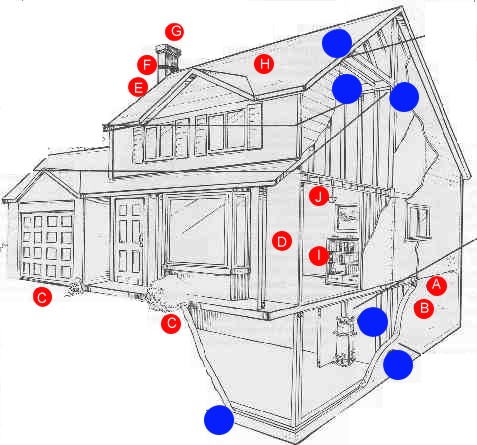How would your home stand up?
Table of contents
Reducing Earthquake Damage To Your Home
If your house is close enough to a large earthquake, it may suffer some structural damage. However, you can take steps to minimize the extent of this damage. By reinforcing the foundation, floors, walls, and roof and by securing the contents of your house, you can improve its ability to withstand lateral and vertical forces. Houses that absorb and evenly distribute horizontal shifting fare best in an earthquake.
You can complete some of these steps yourself, but others may require the expertise of skilled professionals, such as qualified engineers, contractors, or tradespeople. Professional structural engineers can provide an unbiased opinion about necessary improvements.
The Site Factor
- Old or leaning trees, electrical wires, and power lines close to the house are a potential hazard.
- Reinforce large or irregular canopies or porches to prevent them from separating from the main part of the house. Consider a stronger frame or a smaller, regular shape for your canopy or porch when you build or renovate.
- A steel-reinforced floating slab with thickened edges can be effective in poor soil. If possible, extend foundations into solid, undisturbed soil.
- Look for other potential earthquake hazards (faults, dykes, reservoirs, water towers, or poorly constructed buildings) near your property. Consider relocating if the risk is great enough.
The Soil Factor
Local ground conditions can change the characteristics of earthquake motions. Have the local building authority or soil engineers check the soil conditions of your property. If your home is situated on poor soil, its foundation should be reinforced.
Poor - deep loose sand; silty clays; sand and gravel; and soft, saturated granular soils.
Earthquake forces are amplified on water-saturated soils, changing the soil from a solid to a liquid. The quicksand effect makes the ground incapable of supporting a foundation. The ground can crack or heave, causing uneven settling or building collapse.
Good - bedrock (deep and unbroken rock formations)and stiff soils.
These soil types are best since much less vibration is transferred through the foundation to the structure above.
Reducing Earthquake Damage

- Adding steel t-straps
- Adding metal roof ties
- Using steel connectors
- Using anchor bolts
- Securing water heaters and gas appliances
- Reinforcing walls with plywood sheathing
The diagram (above) illustrates some steps that can be taken to safeguard your home against earthquake damage.
- Replace unreinforced masonry or deteriorating concrete foundations with reinforced concrete.
- Add concrete foundations under walls that lack support.
- Add a steel frame or plywood panels to both sides of garage door and window openings. Secure frame to foundation with anchor bolts.
- Check exterior masonry, especially brick or block veneer, periodically. Repair cracks to prevent toppling during an earthquake.
- Reinforce ceilings below chimneys with additional plywood sheathing to prevent bricks and mortar from falling through the ceiling.
- Add steel collar braces to chimneys.
- In new houses, use a lightweight flue system or a structural backup wall for chimney masonry.
- Fix loose roof tiles and properly anchor heavy roofing material on a strongly braced roof frame. (Clay tiles are more vulnerable to earthquake pressures.)
- Secure bookshelves to walls with screws or bolts.
- Hang light fixtures and fans from electrical boxes that are securely fastened to ceiling joists. Add safety chains if necessary.
The house's structural elements should be examined for their stability:
- foundation, which supports the structure
- horizontal members (floors and so on), which support and transfer the building's weight and its contents to the walls
- vertical members (support walls, posts, and so on), which transfer the weight down to the foundation
- connection points (bolts, clips, brackets, and so on) between the members
Other Suggestions
- Use closed hooks or safety hangers for pictures and mirrors.
- Put non-skid, padded matting under breakables, such as televisions, stereos, and VCRs.
- Use childproof catches for cabinet doors and rails for display cases.
- Keep flammable items and household chemicals securely upright and away from heat.
- Place valuable items in a fire-resistant place.
- Add shatter-resistant film to windows or use tempered or wired safety glass.
- If your house is non-symmetrical, add restraining elements to minimize twisting and cracking.
- If your house is supported on slender posts or is partially cantilevered (for example, a hillside home on stilts), make sure posts are braced and anchored to solid ground.
- If your home is heated by natural gas, use flexible pipe connections for gas appliances. The semi-flexible material will prevent the line from rupturing. Install a seismic-activated gas valve, which shuts off the gas during severe earthquakes.
Check with your local utility before making these changes as municipal regulations vary from place to place.
Reference Material
- Public Safety and Emergency Preparedness Canada Self-Help Advice for Families and Individuals - Be Prepared, Not Scared
- Helfant, David Benaroya, 'Seismic Bracing,' JLC: New England Edition, March 1990, pp.40-44.
- Institute for Research in Construction, Assessment of Earthquake Effects on Residential Buildings and Services in the Greater Vancouver Area. National Research Council Canada, 1989,34 pp.
- Institute for Research in Construction, Earthquake Damage In the San Francisco Area and Projection to Greater Vancouver. National Research Council Canada, 1990,42 pp.
- 'Quake' (Part I and 11), Sunset Magazine. Sunset Publishing Corporation, 1990.
- Shapiro, Okino and Ham Associates, The Home Builder's Guide for Earthquake Design. Berkeley, California: Applied Technology Council, 1980.
Information Contacts
- For more advice on preparing for earthquakes and other natural disasters, contact Public Safety Canada or your local Emergency Planning Office.
- To find out about insurance coverage,contact the Insurance Bureau of Canada (1-844-227-5422).
- For other housing-related information, call the Canada Mortgage and Housing Corporation (1-800-668-2642) or your local CMHC office.
"Page details"
- Date modified: